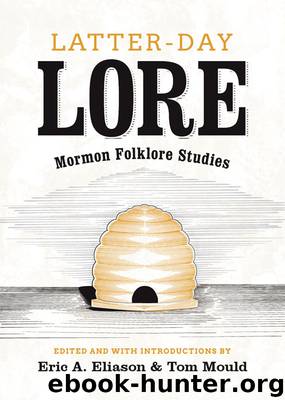LATTER-DAY LORE: Mormon Folklore Studies by Eric A. Eliason & Tom Mould

Author:Eric A. Eliason & Tom Mould
Language: eng
Format: epub
ISBN: 978-1-60781-285-2
Publisher: University of Utah Press
Published: 2013-10-31T16:00:00+00:00
PIONEERS FOR ALL UTAHNS:
THE “DAYS OF ‘47” IN SALT LAKE CITY
In her book Parades and Power, Susan Davis points out the inadequacy of the “common sense” way of viewing parades as “straight forward [sic] reflections” of consensual notions held by all performers and observers. What she says about Philadelphia’s 1832 parade in honor of George Washington’s birthday could also be said about Salt Lake City’s “Days of ‘47” parade. “Upon closer examination … the procession’s meanings for performers and audience seem less unified. This performance was a selective version of local social relationships that hardly represented all communities [and] all points of view.”48 In Salt Lake City as well, some do not share hegemonic interpretations of the pioneer story and feel that Pioneer Day is lacking as a community event because it has featured only the dominant group’s collective historical memory.49
In the “Days of ‘47” parade, notions not only about social relationships but also about the sacredness of certain historical events and the divine destiny of Utah’s dominant culture have been literally paraded in public. But as Salt Lake City’s Gentile population has increased along with Mormon sensitivity to others who call Utah home, the tone of the parade has changed. Mormon themes still dominate the Pioneer Day parade, but parade entries in recent years have employed symbols that bridge the Mormon/Gentile divide or are specifically non-Mormon in character.
One theme that has emerged as a bridge is the completion of the transcontinental railroad.50 As the railroad closed off the time window of the romantic pioneer era, it opened the possibility for a new “progressive romanticism” celebrating the modern world coming to Utah. Today the railroad is remembered as ushering in a new age of Mormon/Gentile cooperation in Utah—a memory open for appreciation by a larger percentage of Utahans.
The inclusion of floats that celebrate the transcontinental railroad is, of course, antithetical to older understandings of what Pioneer Day was designed to celebrate, and it is a sign that the parade is being secularized and broadened to allow for the inclusion of more non-Mormon participants. Another sign of the breakdown of Mormon exclusiveness has been the inclusion of floats honoring the establishment of Salt Lake City’s Catholic cathedral and Jewish synagogue. When speaking to the gathered crowds at the 1992 “Days of ‘47” celebration, LDS Church leader Loren C. Dunn acknowledged the contributions of “pioneers of other faiths” who also came to Utah.51 The official theme of 1994’s “Days of ‘47” celebration was “All Are Welcome Here.” Certainly this theme was chosen, in part at least, as a corrective to the parade’s past exclusivity and Mormon-centeredness. Religious themes—while still important—have lost their dominance in Salt Lake City’s “Days of ‘47” celebration. Floats that promote business establishments and bear corporate logos have become more prominent as well. Reasons other than the remembrance of sacred history, including fun in and of itself, are beginning to undergird the “Days of ‘47” celebration.52
These changes have coincided with shifts in responsibility for organizing the parade. In pioneer Utah, relationships between public events and authority were intimate.
Download
This site does not store any files on its server. We only index and link to content provided by other sites. Please contact the content providers to delete copyright contents if any and email us, we'll remove relevant links or contents immediately.
| Amish | Catholicism |
| Christian Science | Jehovah's Witness |
| Mennonite | Messianic Judaism |
| Mormonism | Orthodoxy |
| Protestantism |
Under the Banner of Heaven: A Story of Violent Faith by Jon Krakauer(1750)
The Early Centuries - Byzantium 01 by John Julius Norwich(1702)
The Amish by Steven M. Nolt(1533)
Taken by J. C. Owens(1529)
In Spirit and Truth (In Spiritu Et Veritate Series) by Reed Zoe(1525)
Play It as It Lays by Joan Didion(1475)
The Apogee - Byzantium 02 by John Julius Norwich(1413)
The Last Man in Russia by Oliver Bullough(1364)
A History of the Amish by Steven M. Nolt(1260)
David Sedaris Diaries by David Sedaris(1244)
Leaving the Witness by Amber Scorah(1214)
Fallen by unknow(1184)
The Dance of Change by unknow(1179)
Tears of the Silenced: A True Crime and an American Tragedy; Severe Child Abuse and Leaving the Amish by Misty Griffin(1178)
The Angel of Forest Hill by Cindy Woodsmall(1125)
The Best of Amish Cooking by Phyllis Pellman Good(1114)
Deep Blue by unknow(1104)
The Ariana Trilogy by Rachel Ann Nunes(1104)
Escape by Carolyn Jessop & Laura Palmer(1086)
